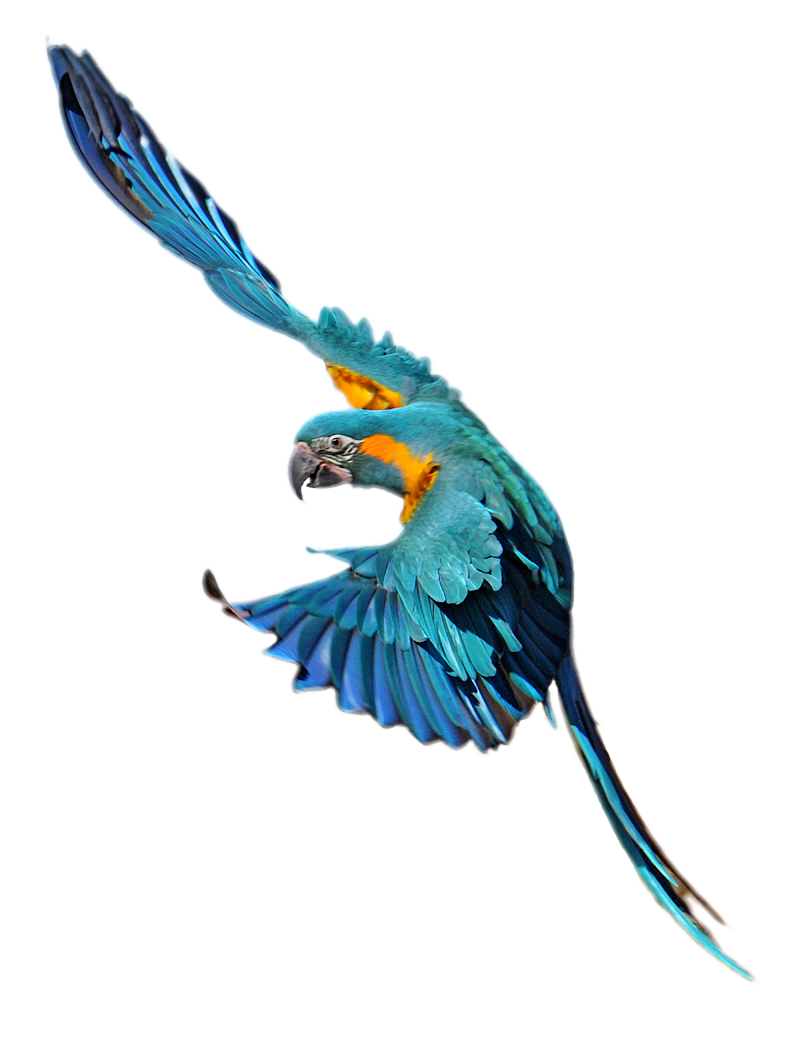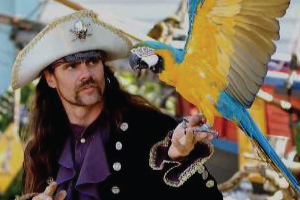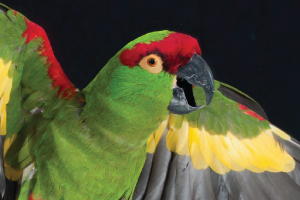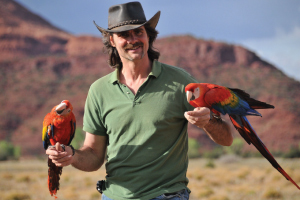
To Harness or Not
Written by Chris Biro, Copyright 2008
The Question: “I saw in this last post the mention of the use of a harness for restraining the movements of a parrot. Is it common? Is there a site I could see such a device?”
I do not like the idea of anything attached to a bird that could become entangled in a tree. A leash to me is far more dangerous than it is of value. If training a baby bird it is my belief that such tools are simply not necessary, even for new trainers. Using a leash on a bird also can limit how much the trainer learns about flight training. Some never seem to be able to get on with real training and stop using the leash “crutch”. But my main concern for them comes from people’s unbelievable ability to be careless. Should a bird wearing a harness and a leash get loose and find itself in one of those really tall trees, way out on a small branch, in one of those locations no truck could ever get near, then you potentially will watch the bird die there. And I have seen people with birds on a leash let them sit on a perch with the leash just dangling over the perch or on the ground. I have had enough accidents where a bird got loose from my own hand to know how easy this can happen. Adding a leash to this could be really bad. (Note: recently this very thing happened to someone who staunchly claimed he always kept the anchor end attached to his belt. He was lucky the bird did eventually get loose and was found a few days later.)
In my early days of exploring flight training methods I tried using a leash with a dog run kind of set up. The birds would have a short leash attached to one leg and then they would fly to me along a 100 ft route with the other end of the leash sliding down a tight string (100 ft long). After they got good at this I started lengthening the leash part so that they had more room to vary from the direct route. At some point they were no longer tugging at the end of the leash and flew just like they did not have a leash on. The leash was extended to be about 30 feet long at some point. It was going well and the leash was a valuable tool for me. Then one day I had an adult Scarlet named Jezebel who I was trying to train to fly who was eager to launch herself toward me but had no clue how to slow her flight. Anything longer than about 6 feet and she was in trouble for landings. Anyway, one day she flew right past me with the long leash on and wound up landing in the tree behind me. I had not realized she could reach it with the leash on. I had a heck of a time getting her out of that tree. She was high enough that I used a tall ladder on the roof of my truck to reach her and then getting her untangled made the situation just that much more difficult. Since then I have been very leery of putting them into situations where they could wind up flying with a dangling string attached them.
The fledgling aged bird comes with a kind of built in mental leash already installed. That parental bond does exactly that, it helps keep the bird focused on staying close to “mom”/hand-feeder.
I am interested in exploring ways to use a harness that I could find acceptable. It has been pointed out to me how many more people are getting their birds outdoors and doing some flying due to using a harness. I can see the benefit to that. And though I still believe that there are significant risks involved with the use of a harness, I am willing to concede that the benefit gained by so many people getting birds outdoors may make it worth taking those risks.
But I am not yet sure how to define what I would consider acceptable. I am not sure I think putting a harness on a pet bird for non training purposes is acceptable. But possibly as a training tool, and then at some point no longer needed. That, I think, I maybe could find acceptable. I am very interested in hearing people’s thoughts on this. Email me your comments.
Parrots more than pets, friends for life.Chris Biro
Resources and More
The Pirate's Parrot Show
An educationally based pirate-themed parrot show performing at state and county fairs since 1991. The Pirate’s Parrot Show is a Fun, Educational, and Interactive experience for all ages and cultures.
Bird Recovery International
One in every eight bird species in the world today is in danger of extinction and these numbers are increasing! Find out how this non-profit organization started by Chris Biro can help save and protect parrots and other birds.
Podcasts with Chris Biro
An Alternate Perspective – Enjoy these audio Podcasts of Chris with guests discussing the nature of training flighted birds. The discussions are intended to be loosely structured around a general topic.
Email Us
chris@libertywings.com
Call Us
(206) 618-2610
Contact Us
By Using the Contact Form




Chris,
I use a harness system simply because I am not comfortable with my birds level of training and my inexperience as a trainer. I use an Aviator flight harness that has a bungie leash attached to 100 foot of Kite Sailing kite line that I stake one end into the ground giving me about 200 feet of flight distance. I make sure the diameter does not reach any obstacles or trees. I usually do A to B flights with my wife and I. On occasion my bird will do a couple of circle before returning to one of us for a landing. Rarely she will take off but will be turned around by the line then return to us. She seems to know the limit because her circles usually do not reach the end of the line.
If I did not use the line she would not be getting the almost daily exercise that she now gets. Nor would she be enjoying the outside as much as she does. My ultimate goal is to get her free flighted but I do live in the New York City and I am sure it is a high level flight situation. I am saving up for your back to back 7 day flight class but not sure when I will be able to make that happen.
I feel that if you can’t free fly your bird I think the next best thing for the bird would be to use a flight line as opposed to keeping it inside.
Kind Regard,
Ralph
Thanks for the feedback. If the harness were not an option for you, would you have worked a bit harder to learn to improve your training skills? Have you scouted out appropriate flying locations, maybe out in the neighboring countryside? Is the harness actually helping you meet that goal of flying her outdoors or is it helping keep you stuck at this level?
I don’t know what your situation is but I suspect you are similar to a lot of other people out there using a harness. I look forward to hearing more about this. Thanks again for posting. Chris
Hi Chris,
My husband & I also use a harness for our 2.5 year old African Grey, Bertie. We would love to free fly him, & I’ve been reading your website with interest & thinking carefully about whether we have the necessary training skills to do this. However, we live in central London which, like New York, isn’t the most suitable place to free fly a parrot. There are lots of gardens, trees, & parks in our area, but there are also busy roads, the river, and lots of houses.
Ultimately, we would like to just be able to leave the back door open so Bertie can come into the garden with us without us worrying about losing him, & we’d also like to be able to take him to friends’ houses and not worry all the time about doors & windows being closed etc. I’m not sure if this is a realistic goal, especially in a city, and I would be very interested in hearing your thoughts about this. For example, would you take your birds round to a friends’ house & sit with them in the garden, or is it a risk that you just wouldn’t take?
I completely agree with you about the dangers of getting the harness or line tangled in branches etc., so I am absolutely rigorous about having the leash around my wrist all the time. But I agree with Ralph above: on balance, I would say it’s preferable to let your parrot experience the outdoors wearing a harness, rather than never letting it outside, or clipping its wings, which I personally think borders on abuse. I also think there are many people who don’t want to free-flight train their parrot, but they still might want to take it out and about with them, in which case a harness might be the perfect solution.
Thanks for your great website & videos – Bertie & I have been watching them with interest!
All the best
Harriet
Yes it is possible for pet parrots to learn to have such self control and confidence to go with you anywhere you go. Do I take my birds to friends homes to hang out in the yard with us, not usually. I have come to a point where I love flying my birds but I also really hate doing recovery work I don’t need to do. So I evaluate situations I might fly the bird to determine if the potential for a flyoff is worth the benefit if flying them there. Flying at a friends yard to me is not worth that risk. The risk is going to be higher there than many of the places I fly and the recovery effort itself will be more difficult. I do not know much about the area, my birds don’t know the area, most people I know live in residential areas with power lines, cats, dogs, etc. So unless there is some specific benefit that I really value, I probably would not fly my birds at my friends home. Hire us to do a show at fair, a birthday party, teach a flight training seminar with flight demos, etc. then yes for me that counts as a benefit worth taking the risks. At home we do take them to complex locations to build their skills or to take video and photos and yes I consider those as worth the risks too. Each of us has our own version of what is worth facing those risks. For you, flying at your friends might be well worth it. And if you do it often then the risk will come down as you and your birds get to know the area.
I worry about people using a harness as a crutch, thinking it is giving them security when like wing clipping the bird can still get into trouble getting into the air. More than this though people comment to me that they are using a harness and cannot move on to flying without it. If flight training is approached correctly in the first place a harness is not needed at all. So how many people are “flying their bird” on a harness when they could be flying them without the harness? Are people choosing the easier harness route and then getting stuck or would they have learned to train flight anyway but without the harness? The answer seems to be that more people are leaving their birds unclipped and using the harness who probably would not have learned to train their birds to fly without it. So the next question is are people moving on from the harness to flying without one?
Thanks Chris, that’s really interesting,
I should have said that we don’t use the harness specifically to fly Bertie, but use it just to enable him to come out with us (he comes to the pub sometimes, & out to the park, round to friends’ houses etc.). We definitely intend to train him in free flight, in which case we would not use a harness at all as I agree with you – it’s best that we have good training skills instead of using the harness as a crutch. However, living in a city centre does make finding a location for free flight a little more complex.
Even if we are successful in free flying Bertie, I still see myself using a harness in some situations -e.g. if he was out with us in our garden, or we were taking him to a friends’ house, as although we may not want to fly him under these circumstances, we would still like him to be out with us – does this sound like a reasonable conclusion?
All the best
Harriet
One of my cockatiels just loved to have a bit of string attached to her leg. The challenge of untying the knot made her day. As for a leash, all the computer and electrical wiring has to go through hose pipes in my place. They will ALL home onto any exposed bit of wire to chew it up.
So I would not trust a cockatiel to a leash, whatever the fixing or the material. It might take them a while but they will find a way to get loose, not necessarily because they want to escape but just because it would be fun to fiddle with the leash.
Hi Chris,
thank you for all the great information you’re providing us.
What do you think of using falconry anklets and jesses, as opposed to using a harness? Would you find that more acceptable than a harness as an intermediary step in the process of us learning to teach free flight to our birds?
I have a rescue rook who is now about 3.5 month old, and cannot be released. I really hope to be able to teach him free flight and reliable call back so he can enjoy as much freedom as possible. I don’t feel comfortable enough to take him out without anklets and jesses at the current time, though.
Thank you for your feedback
Best wishes
Nathalie (from France)
Nathalie,
The first issue for me is having a string attached to a bird that gets loose. If it is attached to a harness or ankle jesses makes little difference. The main concern is the bird getting loose with an attached string that can become entangled in a tree or power line, etc. If the person is really careful and vigilant then this should never happen. But this takes practice and a real dedication to being mindful that many people are not prepared for. When I first started experimenting with flying parrots, I used an ankle jess setup and kind of a dog run line. It worked well enough. But I did have a scarlet macaw become entangled in a tree at the edge of the field. That was where I learned about the risk of entanglement. Then later as I improved my training approach, I learned the tether line was not necessary at all if you approach your training right. I know that when people first start learning about flight training they lack confidence in themselves and what they are doing. But here is the deal as I see it. If people cannot be mindful enough to follow my instructions well enough to make this work without a tether, then they will not likely be mindful enough to use a tether without letting the bird get loose while wearing the tether. The approach I describe on this website works. It works well. And many people have followed this approach with great success. No tether needed. I don’t consider a harness or ankle jess evil. Many people use them and many birds are getting out doors and doing some limited flying through use of a harness or ankle jess. Some people believe this is a good thing, and it probably is. I cannot help wish to see people get their bird flying through good training instead of relying on a tether.
Thank you Chris. I understand what you mean. I’ll definitely be trying it with my rook!